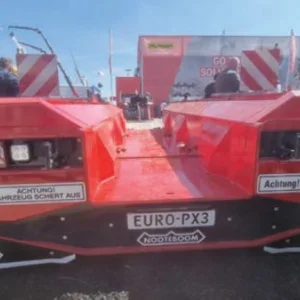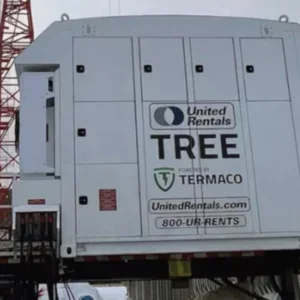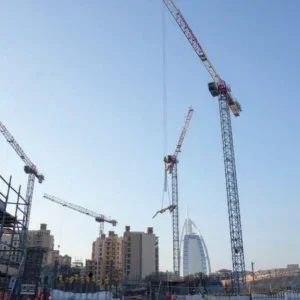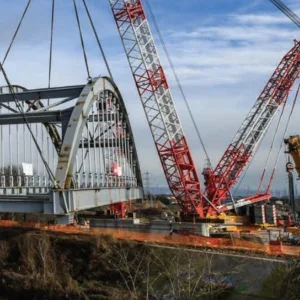Conexpo was upbeat – buzzing with busy buyers. Because demand so outpaces supply, equipment rental rates are up and so are manufacturers’ orders. More than 124,300 visitors came to gawk at the machinery shown by 2,000 exhibitors. 21,200 came from outside the USA. There was plenty to see.
Tower cranes
Manitowoc told Cranes Today that it is likely to start building tower cranes in North America by 2007. Currently, the company relies on imports from its French tower crane subsidiary, Potain.
But with strong demand, and the weakness of the dollar relative to the Euro, the company is making other plans.
It announced two big orders worth a total of $45m, 60 cranes for $30m to US rental company AmQuip and 60 cranes for $15m for French tower firm Sofral.
“The North America order is key for us. That’s a growth opportunity,” Glen Tellock, Manitowoc Crane Group president and CEO, told Cranes Today.
Manitowoc US tower crane manager Clay Thoreson said: “I can say the overall market in North America has improved dramatically over 2004. And that our customers remain optimistic looking ahead into 2006.”
Tellock said the company’s existing crawler factory in Manitowoc, Wisconsin would be the likely site for tower crane construction, though the start is some way off yet. “Probably not 2006,” he said, adding also that any tower crane fabrication would have to be balanced with crawler crane demand.
“There are a very small amount of towers in the US,” Philippe Cohet, Manitowoc executive vice president, Europe, Middle East and Africa, told Cranes Today. “Since we see the potential, we are working on plans to produce cranes in the USA. That is part of our ambition to manufacture in different parts of the world.
“We are playing with the data now. Nobody produces tower cranes in North America. We are a global leader. I guess it is our job to make something happen,” Cohet said.
Outside of Potain’s factories in France, Portugal and Italy, it also makes tower cranes and crawler crane boom sections and counterweight in its factory in Zhangjiagang, Jiangsu Province, China.
AmQuip’s orders
Manitowoc announced a two-year,
$30m sale of 60 large tower cranes to California’s Coast Crane for customer AmQuip. Thirty will be delivered by the end of the year, and the other 30 will follow. The order includes MD 485 B with 80m jib, and MD 560s and MDT 302s.
Terex also announced a $30m order from AmQuip, for a mixture of SK 575, SK 415 and SK 315 (see news pages).
Amquip had between 20 and 30 tower cranes before the show.
“There is a need for tower cranes in the US,” said Dennis Bates, AmQuip vice president of tower cranes. “So we have been buying as many as possible used. We needed to find a long-term partner. We will take delivery of the cranes over the next two years.”
Amquip believes that every tower crane in the US is working, and that rental rates are up 20% over the last 12 months.
Bates, formerly of American Pecco, Morrow, Noell, and most recently Maxim, joined AmQuip in January.
Philippe Cohet of Manitowoc said that Potain’s production is working at near maximum capacity. “We are pretty booked until the end of the year,” he told Cranes Today. He said the factories have taken on staff, increased staff working hours, continued production over the weekend, and outsourced more part assembly operations to try to keep up with demand.
He added that Potain has also had to be more ruthless about putting strategically important orders first. “But my main concern is suppliers – they are slowing us down,” Cohet continued. Slewing rings, engines, cables, gear boxes, and especially steel are becoming scarce, he said.
The new Chinese factory currently being built will not help the current shortage of tower cranes this year, because it will not begin increased production until early 2006, Cohet said. Once up and running, the 70,200 sq m factory’s output will be doubled, with a dedicated line for crawler boom sections and counterweight.
All-terrains
Liebherr Ehingen has announced it is working on the first prototype of the LTM 1200-5.1, which should be finished in a few months. Deliveries will start by the end of the year.
The crane can lift 200t (220 US tons) over the rear at 3m (10 ft) with 72t (80 US tons) of counterweight, additional pulley block and special equipment. With 52t of counterweight, and no special equipment, it can lift 133t at 3.5m radius.
The crane’s seven-section, 72m-long oviform boom, can raise loads to just over 70m (230ft) high. The Telematik system provides automatic or manual telescoping, or extending the boom under partial load. A bi-parted swing-away extends from 12m (40ft) to 22m.
The fully-extended crane can lift loads to 66m radius – 1.5t, 72t of counterweight, 1.1t, 52t of counterweight.
Hoist winches pull with a maximum 105kN (225 lbs) of force, and maximum 140m/min (460 ft/min) line speed. The crane drive is powered by a Liebherr 145kW (197HP) turbo-diesel engine compliant with step 3 and Tier 3 emissions control.
The five-axle carrier is powered by a Liebherr 370kW (503hp) turbo-diesel also complaint with step 3 and Tier 3, which turns the wheels through a ZF AS-Tronic transmission with intarder and two-stage transfer case. The third, fourth and fifth axle of the five-axle carrier will steer at slow speeds, and lock into a forward position at high speeds. 10×8 drive is optional. The Niveaumatik suspension system helps to cushion shocks.
It replaces the five-axle LTM 1200/1 launched at Bauma in 2001, which featured a 60m boom.
Link-Belt announced that it would launch the ATC-3200, a 200 US ton (180t) five-axle AT in the US in the autumn.
It also showed the prototype of the 130 US ton (118t) ATC-3130 II all-terrain, launched in December.
Both cranes are badged Tadano-made models, the ATF 160G and 110G.
Both cranes were also shown on the Tadano stand, about 200m away. Although Tadano America Corp sells the cranes in the US. It has sold ten 160Gs since the crane was launched last year.
Still, product manager Rick Curnutte said the two do not compete head-to-head in North America because of their distribution networks.
The 200 tonner has a computer control that compensates for boom deflection when the crane picks up a load, and automatically raises the boom cylinder so the load does not swing out. Tadano calls this feature “Lift Adjuster”; Link-Belt calls it “Load Com”, short for “Load Compensator”.
The 130 tonner features a hydraulically-raised middle axle, which helps it comply with the USA’s road transport regulations which favour a long wheelbase (19ft is standard).
Link-Belt’s 90 US ton (85t) capacity truck crane, the HTC-8690, has received 100 orders since it launched last August. It has 140 feet of main boom in five sections.
The crane can carry 5.75 US tons of counterweight, plus block, ball and fly jib.
Rough terrains
Terex Cranes is planning to shake up its rough terrain crane manufacture and distribution, its president Steve Filipov told Cranes Today at Conexpo.
Filipov said that a 110 US ton (100t) rough terrain crane due to reach the market before April 2006 would have a boom manufactured by Terex-Demag, and an undercarriage made by Waverley.
“This is part of a programme to work more closely together. Demag is the engineering centre for Terex Cranes,” Filipov said. “55% of the revenue of Terex Cranes is Demag. It’s a big part of the business.”
A further 130 US ton capacity model would follow, with a similar design of boom, though scaled up.
It is not the first time Terex RT manufacturers have shopped around. Bendini’s RC 45 uses a boom made by French crane manufacturer PPM.
“PPM has a 100t capacity AT boom, but it has too much overhang,” Filipov said.
Demag would make the boom exclusively for the RT models. “An AT boom doesn’t work,” Filipov said, because they are engineered to be lighter-duty for work on stationary mobile cranes.
This RT is also going to be CE-marked, so it can be sold in Europe. Filipov said that Terex has plans to sell the large Waverley RTs in Europe.
“We are looking at two things: selling US-manufactured product in Europe, and importing Bendini here,” Filipov said.
“Because the market is so hot, we can’t cope with demand. Italy manufactures 260 cranes a year, and there’s some spare capacity. Maybe we can sell some in the US. But on the other hand, there is the poor dollar/Euro currency exchange,” Filipov said.
He said that it would import the Terex-Bendini 30t (33 US ton) capacity A350, 45t (50 US ton) capacity RC 45 and 60t (66 US ton) capacity A600 into the US.
Terex-Waverley models to export to Europe would be the 35t capacity 335, 55t capacity 555, 65t capacity 665, and 75t capacity 775. The 335, 555, and 775 models have already been CE marked, according to Terex Waverley sales manager Bruce Kramer, for a Bechtel construction job to be carried out by contractor Bechtel on an Iceland smelting facility. Bechtel bought about 20 units, he said, the first of which were shipped in January.
Terex Cranes acquired Koehring Cranes in Waverley, Iowa in 1987, and Bendini in Crespellano, Italy in 1995.
Boom trucks
Elliott Equipment Company launched a 32 US ton capacity boom truck at Conexpo – its largest by 14 tons. Boom length is 105ft in four sections, with tip height of 115ft.
Several units of the 32105 boom truck had sold by the show. Elliott first showed the crane to dealers in December. It features a new thumb-actuated throttle that reduces pedalling fatigue, according to president and CEO Jim Glazer. It also has a newly-designed open operator control station mounted next to the base of the boom.
Several of the Elliott 1800 have also sold since it was launched in December. The 18 US ton capacity crane has a five-section boom with maximum length of 81ft, and competes with the year-old Tadano TN 1882, also on show.
The company also exhibited a prototype of the 1800 model with a special A-frame stabiliser that keeps one outrigger foot within the vehicle width, for working in tight areas. The crane, of course, can only work on the side that is fully extended.
Elliott hired staff and machine tools from National, when Manitowoc closed the National Crane facility in Waverly, Nebraska in 2003, and then launched a boom truck line, said Rick Bigbee, director of dealer development.
Manitowoc’s National Boom Trucks showed the 9125A. The 9125A is a new long-boom version of the 9103A. Its boom is about 20ft longer than the 103ft boom of the 9103A. The crane is intended for oil field work. The job involves dropping a long cylinder down a live oil well with a wire feed down the middle to record data on the performance of the well. It uses a variable displacement hydraulic system which helps increase
the smoothness of operation.
Manitex also showed a long-boom wire line crane, the 124WL, of which 50 had been sold since middle of last year, according to Manitex vice president of sales and marketing Scott Rolston.
It also showed the three-axle SC 97 Sky Crane, an aerial platform with 97ft working height and a winch with 2 US ton capacity to 12ft, 1 US ton to 36ft. Thirty have sold since December. The heaviest-duty of the five Sky Cranes, the two-axle SC 85, has been launched since Conexpo. It lifts a maximum load of 12 US tons with 85 ft high working height. Sky Cranes are intended for lifting road signs into place while their concrete footings are poured. The cranes were redesigned from the originals made by Phoenix, which Manitex acquired in July 2003. US code prohibits the driver from operating the crane from the basket, he said.
“Business is fantastic,” Rolston said, adding that much of the double-digit decline of the last four years had been reversed. He said the company was adding more shifts and redesigning the factory to cope with the extra demand.
Altec’s newest crane on its stand was the 26 US ton capacity AC 26 boom truck launched late last year. The crane has boom lengths of 103ft or 95ft. At least 10 had been sold. The crane also features a work area limitation system and interlock that prevents the boom being raised if the outriggers are not deployed.
Crawler cranes
Following a meeting at Conexpo, US crawler crane vendors have not come to an accord on how to restart sharing crawler crane market figures (CT March, p7). (For more Conexpo crawler news, see our feature this month).
The most likely scenario now is that the manufacturers would share sales data for not only the USA, but the entire world. The manufacturers would report retail shipments country-by-country.
The Association of Equipment Manufacturers, which is organising the data sharing, will contact crawler crane manufacturers around the world to cooperate, according to Ingo Schiller, Liebherr Cranes Inc executive vice president, sales.
“We have made very good progress, but we have not reached endgame,” Schiller said.
He added that he is not concerned that this new initiative seems ambitious. “You always start out reaching for the highest standard, the best participation of all manufacturers, and unless you aim for that, there is no chance of achieving it. You may end up with something less, which doesn’t mean it’s not good, but it’s just a compromise.”
Schiller said that the Conexpo meeting was his first on the subject.
“I’m brand new to this process, and
my patience has not been tried.”
Others at Liebherr were more sceptical.
Every company involved seems to believe strongly that only those who participate should get the data. Scott Moreland, Liebherr Nenzing VP sales, is sceptical. Even if the data sharing pool only consists of manufacturers that sell cranes in the USA, Manitowoc, Terex and Link-Belt might find it difficult to resist the impulse to share data with Kobelco, IHI and Hitachi-Sumitomo, respectively, with whom they have a manufacturing alliance.
“If the Japanese won’t sign up, Liebherr won’t do it,” Moreland said.






